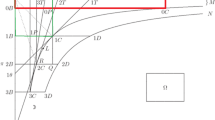Abstract
I critically examine some recent work on the philosophy of scientific fictions, focusing on the work of Winsberg. By considering two case studies in fracture mechanics, the strip yield model and the imaginary crack method, I argue that his reliance upon the social norms associated with an element of a model forces him to remain silent whenever those norms fail to clearly match the characteristic of fictions or non-fictions. In its place, I propose a normative epistemology of fictions which clarifies a model’s ontological commitments when the community of scientists lack any clear, shared norms of use. Specifically, I will introduce a variational account of fictions as an extension of Laymon’s monotonic improvability account of idealizations. I will conclude by connecting this variational account of fictions to didactic fictions in general.
Similar content being viewed by others
References
Anderson T. L. (1994) Fracture mechanics: Fundamentals and applications. CRC Press, Boca Raton, FL
Bokulich A. (2008) Explanatory fictions. In: Suarez M., Fine A. (eds) Fictions in science: Philosophical essays on modeling and idealization. Routledge, New York, pp 91–109
Bokulich A. (2011) How scientific models can explain. Synthese 180: 33–45
Burdekin F. M., Stone D. F. W. (1966) The crack tip opening displacement approach to fracture mechanics in yielding materials. Journal of Strain Analysis 1: 145–153
Cartwright N. (1983) How the laws of physics lie. Oxford University Press, Oxford
El Haddad M. H., Smith K. N., Topper T. H. (1979) Fatigue crack propagation of short cracks. Journal of Engineering Materials and Technology 101: 42–46
Fine A. (1993) Fictionalism. Midwest Studies in Philosophy 18: 1–18
Fjeldstad A., Wormsen A., Härkegård G. (2008) Simulation of fatigue crack growth in components with random defects. Engineering Fracture Mechanics 75: 1184–1203
Giere R. N. (2009) Why scientific models should not be regarded as works of fiction. In: Suarez M., Fine A. (eds) Fictions in science: Philosophical essays in on modeling and idealization. Routledge, New York, pp 248–258
Giere R. N. (2010) An agent-based conception of models and scientific representation. Synthese 272: 269–281
Kim J. H., Lee S. B. (2000) Fatigue crack opening stress based on the strip-yield model. Theoretical and Applied Fracture Mechanics 34: 73–84
Laymon R. (1987) Using Scott domains to explicate the notions of approximate and idealized data. Philosophy of Science 54: 194–221
Laymon R. (1989) Cartwright and the lying laws of physics. The Journal of Philosophy 86: 353–372
Lazzarin P., Tovo R., Meneghetti G. (1997) Fatigue crack initiation and propagation phases near notches in metals with low notch sensitivity. International Journal of Fatigue 19: 647–657
Nishimura T. (2002) Strip yield analysis of two collinear unequal cracks in an infinite sheet. Engineering Fracture Mechanics 69: 1173–1191
Ostash O. P., Panasyuk V. V. (2001) Fatigue process zone at notches. International Journal of Fatigue 23: 627–636
Suarez M. (2004) An inferential conception of scientific representation. Philosophy of Science 71: 767–779
Suarez M. (2009) Scientific fictions as rules of inference. In: Suarez M., Fine A. (eds) Fictions in science: Philosophical essays in on modeling and idealization. Routledge, New York, pp 158–178
Suarez M. (2010) Fictions, inference, and realism. In: Woods J. (eds) Fictions and models: New essays. Philosophia Verlag, Munich, pp 225–245
Taylor D. (2007) The theory of critical distances: A new perspective in fracture mechanics. Elsevier BV, Oxford
Taylor D., Saeid K. (2008) A comparison of critical distance methods for fracture prediction. International Journal of Mechanical Sciences 50: 1075–1081
Teller P. (2004) How we dapple the world. Philosophy of Science 71: 425–447
Teller P. (2009) Fictions, fictionalization and truth in science. In: Suarez M., Fine A. (eds) Fictions in science: Philosophical essays in on modeling and idealization.. Routledge, New York, pp 235–247
Usami S., Kimoto H., Takahashi I., Shida S. (1986) Strength of ceramic materials containing small flaws. Engineering Fracture Mechanics 23: 387–394
Waddoups M. E., Eisenmann J. R., Kaminski B. E. (1971) Macroscopic fracture mechanics of advanced composite materials. Journal of Composite Materials 5: 446–454
Westergaard H. M. (1939) Bearing pressures on cracks. Journal of Applied Mechanics 6: 49–53
Winsberg E. (2003) Simulated experiments: Methodology for a virtual world. Philosophy of Science 70: 105–125
Winsberg E. (2006a) Models of success versus the success of models: Reliability without truth. Synthese 152: 1–19
Winsberg E. (2006b) Handshaking your way to the top: Inconsistency and falsification in intertheoretic reduction. Philosophy of Science 73: 582–594
Winsberg E. (2009) A function for fictions: Expanding the scope of science. In: Suarez M., Fine A. (eds) Fictions in Science: Philosophical essays in on modeling and idealization. Routledge, New York, pp 179–191
Author information
Authors and Affiliations
Corresponding author
Rights and permissions
About this article
Cite this article
Purves, G.M. Finding truth in fictions: identifying non-fictions in imaginary cracks. Synthese 190, 235–251 (2013). https://doi.org/10.1007/s11229-012-0144-5
Received:
Accepted:
Published:
Issue Date:
DOI: https://doi.org/10.1007/s11229-012-0144-5




